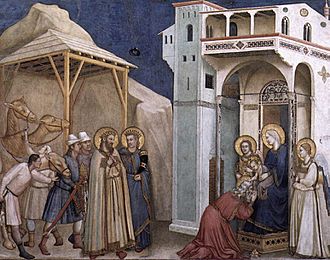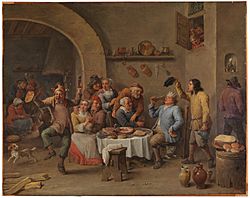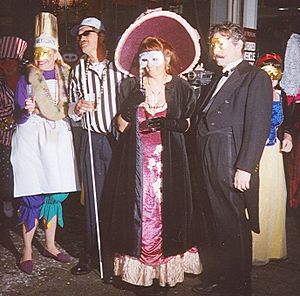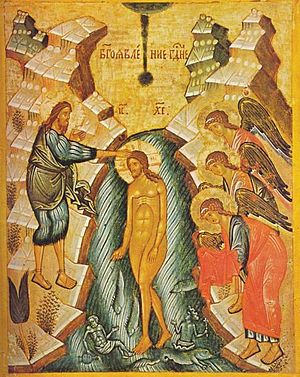Twelve Days of Christmas facts for kids
Quick facts for kids Twelve Days of Christmas |
|
|---|---|

|
|
| Observed by | Christians |
| Type | Christian |
| Observances | Varies by denomination, culture, and nation |
| Date | 25 December – 5 January, inclusive |
| Frequency | annual |
| Related to | Christmas Day, Christmastide, Twelfth Night, Epiphany, and Epiphanytide |
The Twelve Days of Christmas, also known as Twelvetide, is a special Christian season. It celebrates the birth of Jesus. In many Christian traditions, the "First Day of Christmas" is December 25th (Christmas Day). The Twelve Days then run from December 25th to January 5th. January 6th is often called "Twelfth Day" or "Twelfth Night."
For some Christian groups, like the Anglicans and Lutherans, the Twelve Days are the same as Christmastide. However, for others, like the Roman Catholic Church, Christmastide lasts longer.
Contents
History of the Twelve Days
The idea of the Twelve Days of Christmas became official a long time ago. In 567 AD, a meeting of church leaders called the Council of Tours declared these twelve days a holy and festive time. They also said that people should fast (eat less) during Advent. This was to prepare for the Christmas celebration. This decision helped coordinate the different calendars used in the Roman Empire.
Eastern Christian Celebrations
Some Christian churches in the East celebrate Christmas and Epiphany differently. For example, the Armenian Apostolic Church celebrates the birth and baptism of Christ on the same day.
Other Eastern churches, like the Eastern Orthodox and Eastern Catholics, have a twelve-day period between the two holidays. They celebrate Christmas on December 25th and Epiphany on January 6th. These dates are based on the Julian calendar. On the Gregorian calendar, these dates are January 7th and January 19th. So, for them, the Twelve Days end on January 18th.
Eastern Orthodox Traditions
For the Eastern Orthodox, Christmas and Epiphany are very important holidays. They are part of the "Twelve Great Feasts," which are second only to Easter.
The time between Christmas and Epiphany is a special period. It's a time of celebration, not fasting. Christmas itself is a three-day celebration. The first day celebrates Jesus' birth and the arrival of the Magi. The second day honors the Virgin Mary. The third day is for Saint Stephen.
Other important days happen during this period. On January 1st, they celebrate the Circumcision of Christ. This day also honors Saint Basil the Great.
The day before Epiphany, January 5th, is a day of strict fasting. People often don't eat until the first star appears at night. This day is called Paramony. It's similar to Christmas Eve. On this day, they remember Jesus' baptism in the Jordan River.
Western Christian Customs
During the Twelve Days of Christmas, there are both religious and non-religious celebrations.
Christmas Day (December 25th) is a major holiday for Christians. It celebrates the birth of Jesus. It's also a public holiday in many countries, even those where most people are not Christian.
December 26th is "St. Stephen's Day" in Western churches. In places like the UK and its former colonies, it's also a holiday called Boxing Day.
New Year's Eve (December 31st) is a time for parties and celebrations in many countries. It's also known as "Silvester" in some languages, named after Pope St. Sylvester I.
New Year's Day (January 1st) is often a day for rest or more celebrations. In the Roman Catholic Church, it's a special day honoring Mary, the Mother of God. It's also been celebrated as the Feast of the Circumcision of Christ. This is because, in Jewish tradition, Jesus would have been circumcised eight days after his birth.
In many countries, the Solemnity of Epiphany is celebrated on the first Sunday after January 1st. This means it usually falls within the Twelve Days of Christmas.
Other Catholic feast days during this time include:
- St. John, Apostle and Evangelist on December 27th.
- The Holy Innocents on December 28th.
- St. Thomas Becket on December 29th.
- The Holy Family (Jesus, Mary, and Joseph) on a Sunday near Christmas.
- Sts. Basil the Great and Gregory of Nazianzus on January 2nd.
- The Holy Name of Jesus on January 3rd.
Christmas in Medieval England

In England during the Middle Ages, the Twelve Days were a time of non-stop feasting and fun. The celebrations ended on Twelfth Night, January 6th. This was the traditional end of the Christmas season. William Shakespeare even wrote a famous play called Twelfth Night. Often, a "Lord of Misrule" was chosen to lead the Christmas parties.
Some of these traditions came from older customs, like the Roman Saturnalia and Germanic Yuletide.
Colonial North America Traditions
Early settlers in North America brought their Twelve Days traditions from England. They added their own ideas over time. For example, the modern Christmas wreath might have started with these colonists. They made wreaths from local plants and fruits. Wreaths were hung on Christmas Eve and stayed up until Twelfth Night or Epiphany morning. All decorations were taken down by Epiphany morning. A special cake, called a king cake, was also baked for Epiphany.
Modern Western Customs
United Kingdom and Commonwealth
Many people in the UK and other Commonwealth countries still celebrate parts of the Twelve Days of Christmas. Boxing Day, December 26th, is a national holiday. Stories by Charles Dickens, like A Christmas Carol, show key parts of these celebrations. These include eating plum pudding, roasted goose, and wassail. These foods are often eaten at the start of the Twelve Days in the UK.
Twelfth Night is the last day to take down Christmas decorations. It's thought to be bad luck to leave them up after this day.
United States Customs

In the United States, Christmas Day is a federal holiday. It has extra religious meaning for Christians.
The traditions of the Twelve Days of Christmas have mostly been forgotten in the United States. This is partly because of popular stories like those by Charles Dickens. Also, new traditions like Santa Claus and New Year's Eve parties became popular. Today, many stores treat December 25th as the *last* day of the Christmas shopping season. This has led some people to think the Twelve Days *end* on Christmas Day.
However, many American Christians still celebrate the traditional seasons of Advent and Christmas. These include Amish, Episcopalians, Lutherans, Mennonites, Methodists, Moravians, Orthodox Christians, Presbyterians, and Roman Catholics.
Christians who celebrate the Twelve Days might give gifts on each day. Each day can represent a wish for a month in the new year. They might enjoy traditional foods and celebrate until Epiphany morning. Some modern traditions include lighting a candle for each day. People also sing verses from the famous song The Twelve Days of Christmas. A yule log might be lit on Christmas Eve and burned a little more each night. For some, Twelfth Night is the most festive party night. It's also the traditional time to take down Christmas trees and decorations.
See also
 In Spanish: Doce días de Navidad para niños
In Spanish: Doce días de Navidad para niños


